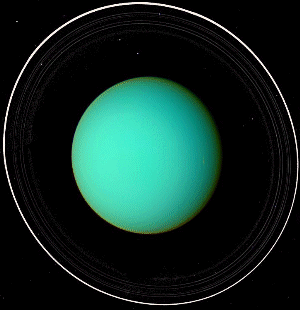
Uranus, A Mysterious Blue-Green Ball
No matter how close we get to Uranus, or how much we enhance the pictures with computers, about all we get to see is a blue-green ball. All the mysteries that surround the planet will not be solved easily.
Uranus is the seventh planet in our solar system, located in between Saturn and Neptune. Its average distance from the Sun is about one and three-quarters billion miles, or about twenty times the distance from the Sun to Earth. The orbit Uranus follows around the Sun is an ellipse, or stretched out circle, which means that Uranus' distance from the Sun varies from about 1.7 billion (1,700,000,000) miles at its closest to about 1.87 billion (1,870,000,00) miles at its furthest away. A year on Uranus is 84 Earth years. A day on Uranus is just a little over seventeen Earth hours. One of the many odd facts about Uranus is that it is "lying on its side" as it faces the Sun. Earth faces the sun standing almost straight up, with the north and south poles at the top and bottom as it looks at the Sun. For some reason, Uranus has rolled over, so what we would think of as the south pole is facing the Sun. Scientists don't know why the planet does this, but it may be the result of a collision with some other body in space. Also, the planet rotates, or spins, from East to West which is the exact opposite of the way that Earth spins.
If you live in a place where the skies are dark and you can see to the southern horizon, you might be able to pick out Uranus with a pair of binoculars. The planet will appear as a faint blue-green light. Even through a telescope, Uranus will only be a small blue-green disc.
Uranus is about four times the size of Earth, just a little over 30 thousand miles in diameter, compared to Earth's diameter of around 7,600 miles. Even though Uranus is much larger than our Earth, it is dwarfed when compared to mighty Jupiter, which is over 85 thousand miles in diameter.

Hubble Telescope Image of Uranus
The Voyager spacecraft showed us the rings, which we cannot see at all from Earth. The only way that Earthbound astronomers can even get a hint of the rings is when they occasionally block the light of a star behind them. Even the Hubble Space Telescope cannot get a very good view of the rings. While the rings of Saturn are made up of fairly small pieces of bright white ices, the rings of Uranus for the most part are made of larger chunks of very dark, rocky material. The darkness of the chunks that make up the rings help explain why we cannot see them from Earth.
Uranus was the first planet to be discovered by an astronomer. It was discovered, accidentally, by British astronomer William Herschel in 1781. This meant that someone had to come up with a name for the new planet. Herschel named it "Georgium Sidus", after the King of England at that time, George III (the King that Americans rebelled against). This seemed fair to Herschel, since the King was paying for his research. Grownups being what they are, others called the planet Herschel, in honor of the discoverer. Another astronomer suggested the name Uranus, an ancient Greek god who was the father of Saturn, so the new planet would have a name from mythology like the rest of the planets at that time, and that name was finally agreed on by everybody in the mid 1800's.
Uranus is another member of the family of gas planets that live in our solar system, but it is quite a bit different from Jupiter and Saturn. First, it has methane gas mixed in with the hydrogen and helium that make up most of the giant planets. Methane is what gives Uranus its unusual color. Second, Uranus appears to have a core, or center, of melted rock, which changes into a dirty ocean made of water, ammonia and other elements the further from the center you go. Finally, the dirty ocean changes into the blue-green cover of clouds that we see in the pictures. Scientists believe that the layer of the planet are not separate, like those of an onion, but gradually blend with one another.
Since Uranus is a gas planet, it doesn't have a solid surface like we have here on Earth. The top layer of gas that we see is far from quiet. By carefully studying the pictures sent back by the Voyager spacecraft, scientists were able to see that there are winds blowing at over four hundred miles an hour!
Back To Main Menu
Use the "BACK" button on your Browser to return to the previous page.